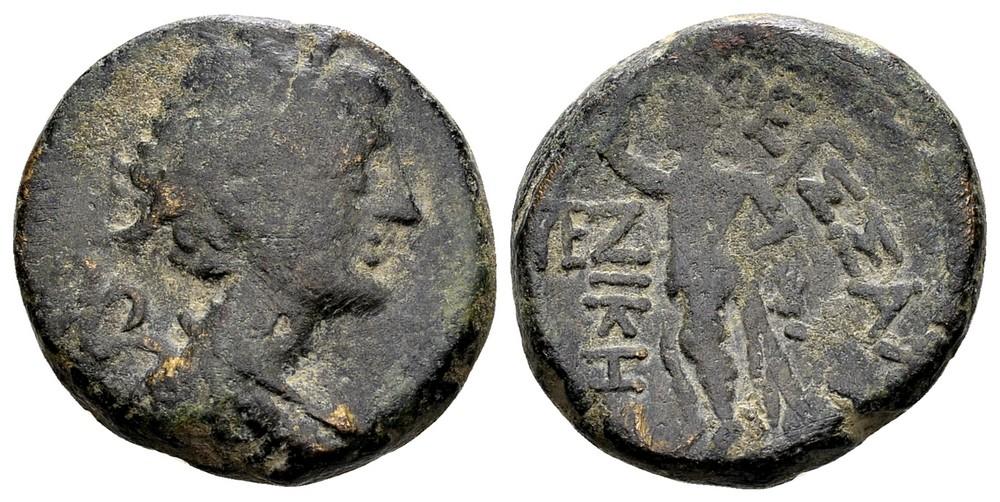Thessalonica (Roman Republic), bronze, ca 10g (Hermes or Zeus/Pand or bull) (114-110 BCE)
From SILVER
(Redirected from S 1336 - Thessalonica, bronze, 114-110 BC)
114 BCE - 110 BCE Bronze
Description
| ObverseInscription or printing placed on the obverse.: | Several types: 1) Head of Hermes right, wearing caduceus (T9), 2) Head of Zeus right, wearing laurel wreath (T10). |
| ReverseInscription or printing placed on the reverse.: | ΘΕΣΣΑΛΟΝΙΚΗΣ (Greek).Several types: 1) Pan left (T9), 2) Bull right. In the field, 2 monograms (T10). |
Mint and issuing power
| MintIdentifies the place of manufacture or issue of a numismatic object.: | Thessalonica | Ancient regionAncient region.: | Macedon | Modern countryModern country: Greece | AuthorityIdentifies the issuing power. The authority can be "pretended" when the name or the portrait of X is on the coin but he/she was not the issuing power. It can also be "uncertain" when there is no mention of X on the coin but he/she was the issuing power according to the historical sources: | Roman Republic |
Chronology
| FromIdentifies the initial date in a range assigned in a numismatic context. | 114 BCE | toIdentifies the final date in a range assigned in a numismatic context.. | 110 BCE | PeriodTime period of the numismatic object.: Hellenistic 323-30 BC |
Physical description
| MetalThe physical material (usually metal) from which an object is made.: | Bronze |
Median weightMedian of the weights of numismatic objects (in grams). in grams | 8.00 | DenominationTerm indicating the value of a numismatic object. Examples: tetradrachm, chalkous, denarius.: | StandardStandard.: |
Image

Thessalonica_Hermes_Pan.jpg [1]
References
| Die study referencePublication of the study: | Kourempanas 20161Kourempanas 2016, τύποι 9-10. | ||
| Coin series referenceReference to coin series study: | HGC 3.12HGC 3.1, n° 725, HGC 3.12HGC 3.1, n° 728 | ||
| Coin series web referenceCoin series web references: | |||
Obverse dies distribution
| FrequencyFrequency of specimen in distribution. ᵖ | Number of obversesNumber of obverse dies. ᵖ (o) | % (o) | Number of coinsNumber of coins. (n) | % (n) | Die nameName(s) of the die(s). |
| 1 | 16 | 45.71 | 16 | 21.62 | E1 (T9), E2 (T9), E6 (T9), E12 (T9), E13 (T9), E14 (T9), E15 (T9), E16 (T9), E3 (T10), E5 (T10), E6 (T10), E8 (T10), E10 (T10), E15 (T10), E16 (T10), E19 (T10) |
| 2 | 10 | 28.57 | 20 | 27.03 | E9 (T9), E1 (T10), E2 (T10), E9 (T10), E11 (T10), E12 (T10), E13 (T10), E14 (T10), E17 (T10), E18 (T10) |
| 3 | 3 | 8.57 | 9 | 12.16 | E7 (T9), E11 (T9), E7 (T10) |
| 4 | 2 | 5.71 | 8 | 10.81 | E3 (T9), E4 (T10) |
| 5 | 3 | 8.57 | 15 | 20.27 | E4 (T9), E8 (T9), E10 (T9) |
| 6 | 1 | 2.86 | 6 | 8.11 | E5 (T9) |
| Total | 35 of 35 | 99.99 | 74 of 74 | 100 |
Reverse dies distribution
no distribution is available
Quantification
| Number of obversesNumber of obverse dies. ᵖ (o) | 35 | Number of singletons (o1)The number of singleton coins. ᵖ | 16 |
| Number of reverse diesNumber of reverse dies. (r) | 54 | Number of coinsNumber of coins. (n) | 74 |
| Coins per obverse dieNumber of coins per obverse die. (n/o) | 2.11 | Coins per reverse dieNumber of coins per reverse die. (n/r) | 1.37 |
| Reverse per obverse ratioRatio of obverse dies divided by reverse dies. (r/o) | 1.54 | Percentage of singletons (o1)number of coins (n) divided by the number of singletons (o1) ᵖ | 45.71 % |
| Original number of dies (O) (Carter 1983 formula)The estimation of the number of coins according to Carter 1983 ᵖ | 54.39 | Coins struck if 20,000 as average productivity per dieCoins made if the average productivity for obverses (according to Carter) is 20,000. ᵖ | 1,087,800 |
| Original number of dies (O) (Esty 2011 formula)The estimation of the number of coins according to the singleton formula in Esty 2011 ᵖ (O) | 66.41 | Survival rate if 20,000 as average productivity per dieSurvival rate if average productivity is 20,000. ᵖ | 0.00007 |
| Coverage (o = % of O) (Esty 1984 formula)Esty 1984 - coverage (% of O) ᵖ (o = % of O) | 78.38% | Die productivity if survival rate 1/2,000Average productivity if survival rate is 1/2,000. ᵖ | 2,721.09 |
| Weight of silver (in kg) if 20,000 coins per die (O = Carter formula)Carter 1983 * Median weight * 20000 (*10 if gold or electrum) ᵖ | n.a. | Die productivity if survival rate 1/5,000Average productivity if survival rate is 1/5,000. ᵖ | 6,802.72 |
Remarks